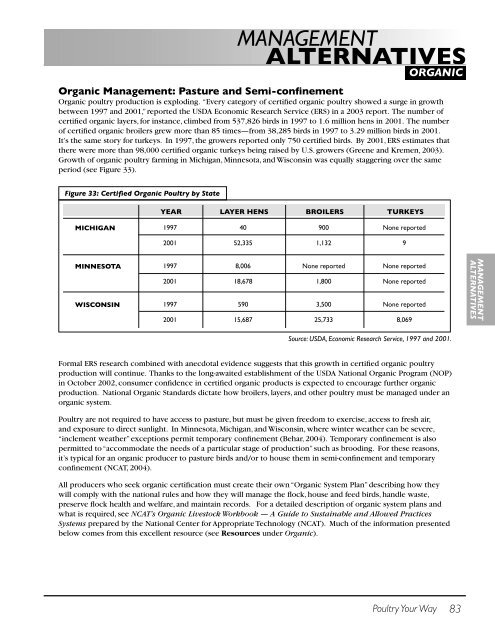Poultry Your Way - Center for Integrated Agricultural Systems ...
Poultry Your Way - Center for Integrated Agricultural Systems ...
Poultry Your Way - Center for Integrated Agricultural Systems ...
Create successful ePaper yourself
Turn your PDF publications into a flip-book with our unique Google optimized e-Paper software.
Organic Management: Pasture and Semi-confinement<br />
Organic poultry production is exploding. “Every category of certified organic poultry showed a surge in growth<br />
between 1997 and 2001,” reported the USDA Economic Research Service (ERS) in a 2003 report. The number of<br />
certified organic layers, <strong>for</strong> instance, climbed from 537,826 birds in 1997 to 1.6 million hens in 2001. The number<br />
of certified organic broilers grew more than 85 times—from 38,285 birds in 1997 to 3.29 million birds in 2001.<br />
It’s the same story <strong>for</strong> turkeys. In 1997, the growers reported only 750 certified birds. By 2001, ERS estimates that<br />
there were more than 98,000 certified organic turkeys being raised by U.S. growers (Greene and Kremen, 2003).<br />
Growth of organic poultry farming in Michigan, Minnesota, and Wisconsin was equally staggering over the same<br />
period (see Figure 33).<br />
Figure 33: Certified Organic <strong>Poultry</strong> by State<br />
MICHIGAN<br />
MINNESOTA<br />
WISCONSIN<br />
YEAR<br />
1997<br />
2001<br />
1997<br />
2001<br />
1997<br />
2001<br />
MANAGEMENT<br />
ALTERNATIVES<br />
ORGANIC<br />
LAYER HENS<br />
40<br />
52,335<br />
8,006<br />
18,678<br />
590<br />
15,687<br />
BROILERS<br />
Source: USDA, Economic Research Service, 1997 and 2001.<br />
Formal ERS research combined with anecdotal evidence suggests that this growth in certified organic poultry<br />
production will continue. Thanks to the long-awaited establishment of the USDA National Organic Program (NOP)<br />
in October 2002, consumer confidence in certified organic products is expected to encourage further organic<br />
production. National Organic Standards dictate how broilers, layers, and other poultry must be managed under an<br />
organic system.<br />
<strong>Poultry</strong> are not required to have access to pasture, but must be given freedom to exercise, access to fresh air,<br />
and exposure to direct sunlight. In Minnesota, Michigan, and Wisconsin, where winter weather can be severe,<br />
“inclement weather” exceptions permit temporary confinement (Behar, 2004). Temporary confinement is also<br />
permitted to “accommodate the needs of a particular stage of production” such as brooding. For these reasons,<br />
it’s typical <strong>for</strong> an organic producer to pasture birds and/or to house them in semi-confinement and temporary<br />
confinement (NCAT, 2004).<br />
All producers who seek organic certification must create their own “Organic System Plan” describing how they<br />
will comply with the national rules and how they will manage the flock, house and feed birds, handle waste,<br />
preserve flock health and welfare, and maintain records. For a detailed description of organic system plans and<br />
what is required, see NCAT’s Organic Livestock Workbook — A Guide to Sustainable and Allowed Practices<br />
<strong>Systems</strong> prepared by the National <strong>Center</strong> <strong>for</strong> Appropriate Technology (NCAT). Much of the in<strong>for</strong>mation presented<br />
below comes from this excellent resource (see Resources under Organic).<br />
900<br />
1,132<br />
None reported<br />
1,800<br />
3,500<br />
25,733<br />
TURKEYS<br />
None reported<br />
9<br />
None reported<br />
None reported<br />
None reported<br />
8,069<br />
<strong>Poultry</strong> <strong>Your</strong> <strong>Way</strong> 83<br />
MANAGEMENT<br />
ALTERNATIVES

















